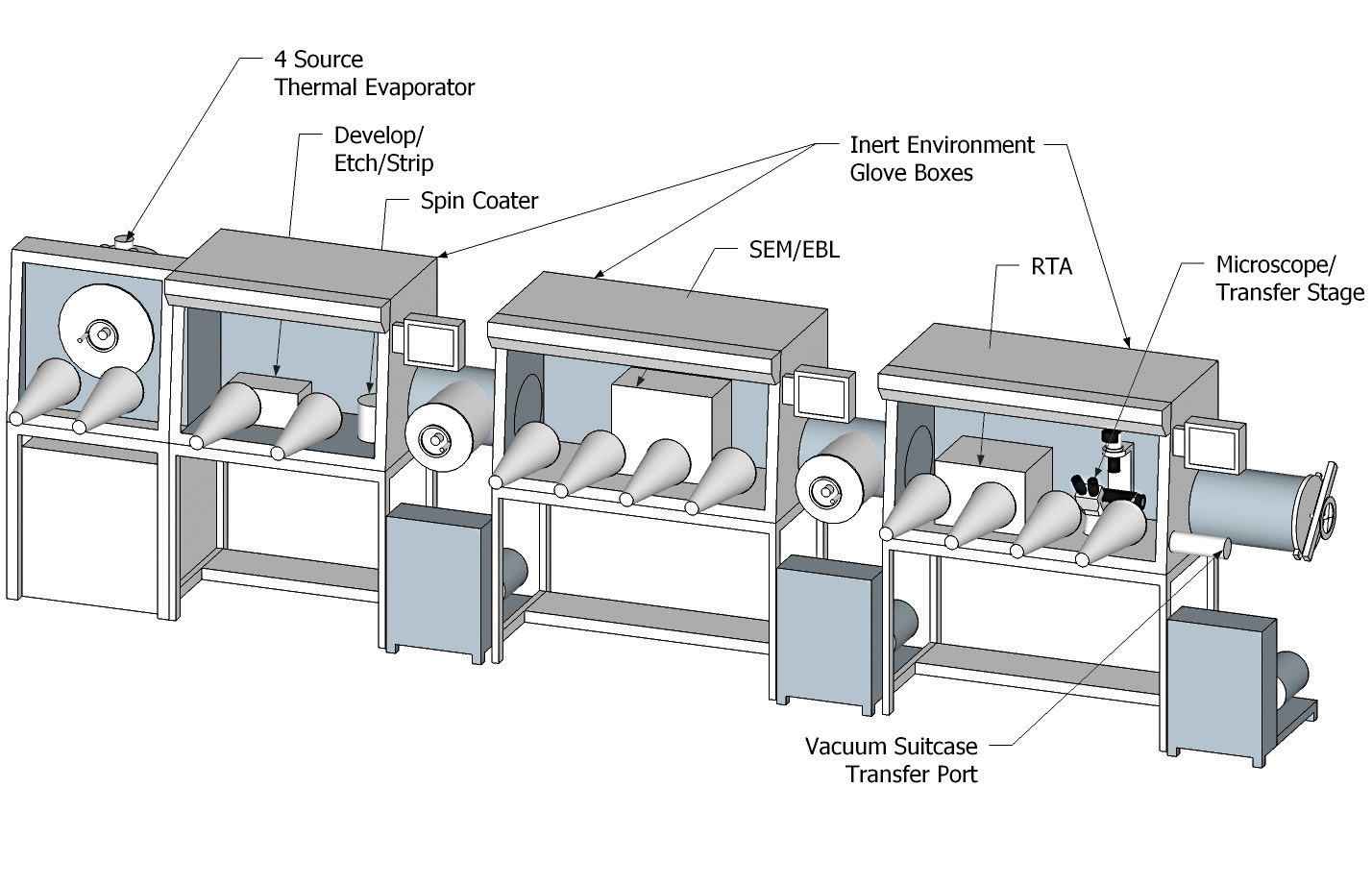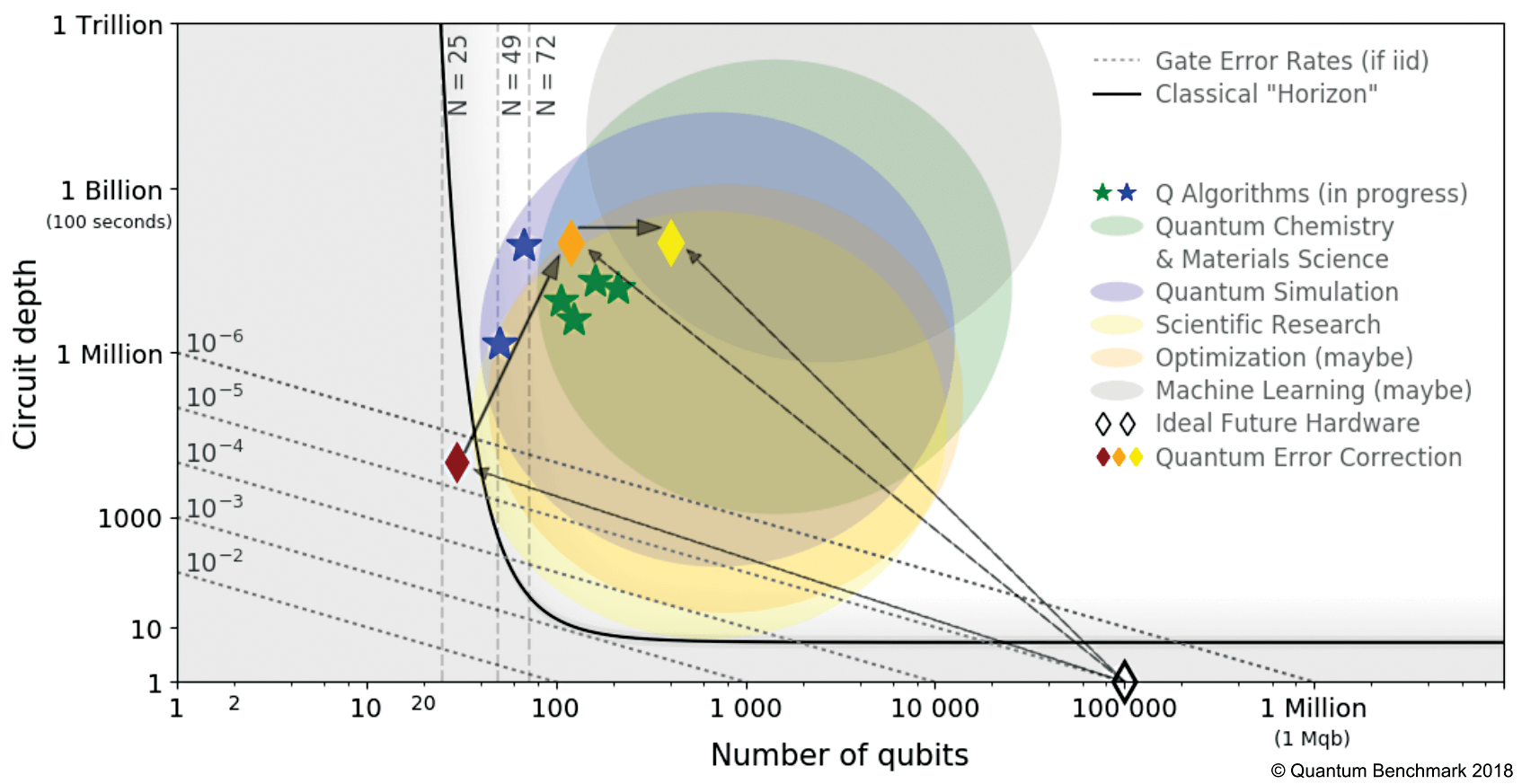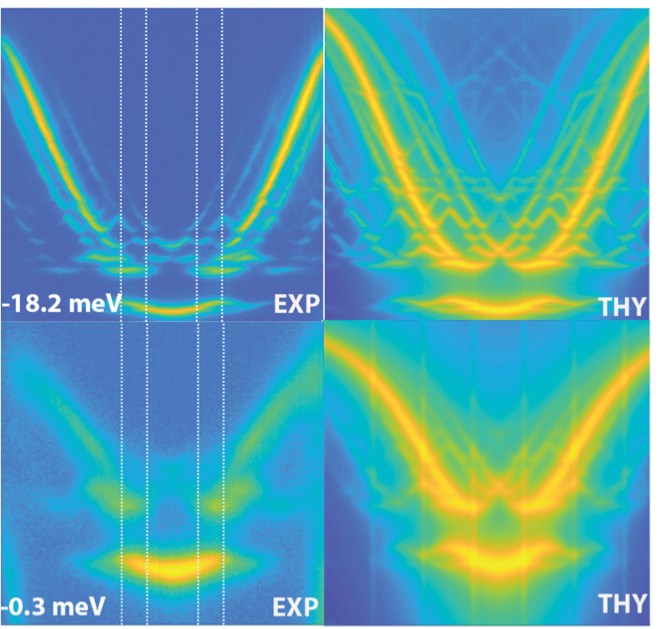
QUANTUM MATTER
Quantum devices must be built from quantum materials. These are distinguished from classical materials by being free of "observers" that would collapse the quantum state
to a classical reality. Quantum materials need to be clean (chemically, electrically, magnetically, morphologically, and structurally) and they need to support quantum coherence.
The quantum nature can be held in atomic scale defects, in nano-structured features, or in macroscopic collective degrees of freedom. Often, they involve multi-body or emergent
physics such as superconductivity or magnetism. Quantum materials are grown in ultra-clean, special purpose instruments that allow us to control defects and structure.

• Better control of interfaces
• Materials for topology and spintronics
• Better rejection of defects


Precise Si whiskers CVD grown single crystal subsurface scanning probe microscopes.

• Better control of interfaces
• Materials for topology and spintronics
• Better rejection of defects

Precise Si whiskers CVD grown single crystal subsurface scanning probe microscopes.

MATERIALS CHARACTERIZATION
The quality of quantum materials is important at extraordinarily low levels. A single atom in the wrong location can degrade the quality and make the material less useful
for storing quantum information. Characterization tools can be sensitive at the level of individual atomic structures. New quantum characterization tools enable us to probe
the quality of materials and optimize the growth conditions. Through characterization, we learn properties of the materials that are essential knowledge for device design and control.
The tools themselves must be quantum systems. Every turn of the quantum innovation cycle leads to new tools that provide better insights into the materials and devices.

• Quantum instrumentation for characterization
• Imaging interfaces without cutting
• Imaging internal magnetic fields
• Subsurface imaging


Nanoscale samples are attached to the tip of the nanowire and placed near a nanoscale magnetic field source for spin detection and imaging.

• Quantum instrumentation for characterization
• Imaging interfaces without cutting
• Imaging internal magnetic fields
• Subsurface imaging

Nanoscale samples are attached to the tip of the nanowire and placed near a nanoscale magnetic field source for spin detection and imaging.

QUANTUM DEVICE FABRICATION
Quantum materials hold a quantum state. Quantum devices have the capacity to control a quantum state. Devices are often composed of many materials along
with integrated control elements (often classical electronics). There is a challenge to assemble these materials in such a way that the interfaces are clean
and precise so that the materials remain free of defects. This is so we can precisely place nano-scale objects on macroscopic devices and that noise
in the classical control elements do not destroy the quantum nature of the materials.
A complementary activity is the development of improved computational tools for device design and control methods.

• Robust to inevitable variation in materials and fabrication
• Fabrication over many length scales
• Fabrication while preserving materials integrity
• Integration of classsical controls into quantum devices

A schematic of a new system for assembly of quantum devices under inert atmosphere.

• Robust to inevitable variation in materials and fabrication
• Fabrication over many length scales
• Fabrication while preserving materials integrity
• Integration of classsical controls into quantum devices


A schematic of a new system for assembly of quantum devices under inert atmosphere.

QUANTUM DEVICE TESTING
Quantum devices typically require specialized environments for testing so that environmental noise does not destroy the fragile quantum state.
This can include operations at extremely low temperatures, extremely small (or large) magnetic fields, and extremely low vibrations. The control systems also
typically require very stable temperatures, humidity and for some systems, very dark spaces.
A particular challenge is that interesting quantum devices cannot be modeled with classical computers.
Therefore, we must find new ways to characterize their power and computing capacity.

• Validation of quantum device capability
• Methods for noise characterization
• Control methods that robust to noise

The convergence of new benchmarking protocols with new analysis allows the computational capacity of quantum processors to be quantified.

• Validation of quantum device capability
• Methods for noise characterization
• Control methods that robust to noise


The convergence of new benchmarking protocols with new analysis allows the computational capacity of quantum processors to be quantified.

QUANTUM APPLICATIONS
Quantum technology emerging from the lab today will transform many fields. Two fundamental applications are quantum error correction and quantum simulation.
These touch and improve every application of quantum. We explore their impact by getting devices into the hands of users, learning from their experience and
integrating that knowledge into the quantum innovation cycle.
Quantum simulation is the key step that closes the quantum innovation cycle.
Through it, we build new understanding of both quantum materials and quantum devices and how to implement them.
Quantum simulators provide a fast way of testing our knowledge and ideas.

• Physics simulation to gain new insight into quantum effects and the design of new materials
• Test beds to explore devices in the hands of early adopters
• Path to, and control of, complex devices (in various applications including security and navigation)

An exciton-polariton quantum simulator is used to study topological properties.

• Physics simulation to gain new insight into quantum effects and the design of new materials
• Test beds to explore devices in the hands of early adopters
• Path to, and control of, complex devices (in various applications including security and navigation)


An exciton-polariton quantum simulator is used to study topological properties.
QUANTUM INNOVATION CYCLE
Leads to improved materials, new devices, and new computers.
Quantum mechanics enables devices and efficiencies of information processing far beyond what can ever be realized in the classical setting. Transformative Quantum Technologies (TQT) aims to provide an environment where quantum devices can be designed, built, and their benefits demonstrated.
TQT’s innovation cycle is built upon five core elements. The cycle begins with growing quantum materials and is closed by simulating quantum materials. In between, we characterize materials, build devices, and integrate them into processors. Each successive generation of materials and devices provides new insights into the design and working of quantum systems.
PHOSPHORUS DEFECTS IN SILICON
Quantum information reverts to classical by a loss of coherence.
We reduce this loss by having cleaner materials and through control sequences that suppress the effects of noise.
QUANTUM INNOVATION CYCLE
Leads to improved materials, new devices, and new computers.
Quantum mechanics enables devices and efficiencies of information processing far beyond what can ever be realized in the classical setting. Transformative Quantum Technologies (TQT) aims to provide an environment where quantum devices can be designed, built, and their benefits demonstrated.
TQT’s innovation cycle is built upon five core elements. The cycle begins with growing quantum materials and is closed by simulating quantum materials. In between, we characterize materials, build devices, and integrate them into processors. Each successive generation of materials and devices provides new insights into the design and working of quantum systems.
PHOSPHORUS DEFECTS IN SILICON
Quantum information reverts to classical by a loss of coherence.
We reduce this loss by having cleaner materials and through control sequences that suppress the effects of noise.

NEUTRONS AS A PROBE
Materials characterization.
Quantum materials have emergent properties that when harnessed, advance applications such as superconductivity, spintronics, sensing, quantum computing, and communications. Characterizing quantum materials requires more than a classical measurement. An important example is the characterization of spin-orbit structures in matter.
Neutrons can probe this since they penetrate matter and are sensitive to magnetic fields. A neutron beam passing through a quantum material records the magnetic structures inside the material. With the National Institute of Science and Technology (NIST), we have built the first facility that is capable of making a quantum measurement of the correlations between magnetization and angular momentum.
UNIQUE CAPABILITIES TO IMAGE INTERNAL MAGNETIC STRUCTURES
The spin/momentum correlation in the neutrons show up as arcs and are unambiguous signatures of quantum states.
NEUTRONS AS A PROBE
Materials characterization.
Quantum materials have emergent properties that when harnessed, advance applications such as superconductivity, spintronics, sensing, quantum computing, and communications. Characterizing quantum materials requires more than a classical measurement. An important example is the characterization of spin-orbit structures in matter.
Neutrons can probe this since they penetrate matter and are sensitive to magnetic fields. A neutron beam passing through a quantum material records the magnetic structures inside the material. With the National Institute of Science and Technology (NIST), we have built the first facility that is capable of making a quantum measurement of the correlations between magnetization and angular momentum.
UNIQUE CAPABILITIES TO IMAGE INTERNAL MAGNETIC STRUCTURES
The spin/momentum correlation in the neutrons show up as arcs and are unambiguous signatures of quantum states.

SELECT USE CASES
Quantum sensors can measure correlations that are not otherwise accessible.
MEDICINE
Correlated information is a very powerful resource in medical diagnostics. For example, knowing how specific chemistry is distributed between the cytoplasm, cell wall, and other structures allows for more accurate setting of surgical margins.
Quantum sensors can be tailored to explore a specific and informative medical inquiry.

Understand biological properties (e.g. chirality, optical activity).
EXPLORATION
Quantum sensing has long played an essential role in oil exploration by correlating fluid type with mobility. It not only allows for the identification of hydrocarbons underground, but also the determination of whether they will move, their viscosity, pore size (confined area), and even the throat size of the pores.
Significant information is obtained from a quantum sensor which is accessible remotely.
Quantum sensors allow more targeted and informative measurements.
SELECT USE CASES
Quantum sensors can measure correlations that are not otherwise accessible.
MEDICINE
Correlated information is a very powerful resource in medical diagnostics. For example, knowing how specific chemistry is distributed between the cytoplasm, cell wall, and other structures allows for more accurate setting of surgical margins.
Quantum sensors can be tailored to explore a specific and informative medical inquiry.

Understand biological properties (e.g. chirality, optical activity).
EXPLORATION
Quantum sensing has long played an essential role in oil exploration by correlating fluid type with mobility. It not only allows for the identification of hydrocarbons underground, but also the determination of whether they will move, their viscosity, pore size (confined area), and even the throat size of the pores.
Significant information is obtained from a quantum sensor which is accessible remotely.
Quantum sensors allow more targeted and informative measurements.
The quantum innovation cycle begins with a simulation problem that is difficult for classical computers to solve: problems ranging from quantum materials to quantum chromodynamics.
TODAY WE ARE JUST CLOSING THE LOOP FOR A FIRST ITERATION

Finally, we learn a bit more about the physics, the materials, the fabrication, and the control. All these build to a next run leading to improved performance.

Superconducting circuits are designed with connectivity and controls tailored to the quantum simulation.
The device is then fabricated and tested in state-of-the-art cryogenic systems.
The microwave controls are optimized for the particular device and tuned to account for errors.
TODAY WE ARE JUST CLOSING THE LOOP FOR A FIRST ITERATION

The quantum innovation cycle begins with a simulation problem that is difficult for classical computers to solve: problems ranging from quantum materials to quantum chromodynamics.

Superconducting circuits are designed with connectivity and controls tailored to the quantum simulation.

The device is then fabricated and tested in state-of-the-art cryogenic systems. The microwave controls are optimized for the particular device and tuned to account for errors.

Finally, we learn a bit more about the physics, the materials, the fabrication, and the control. All these build to a next run leading to improved performance.
THE MOMENTUM IS BUILDING
Every gain in simulations leads to new understanding of materials.
Every advance in instrumentation leads to new science and commercial opportunities.
Every discovery in sensing leads to new opportunities for early adopters.























